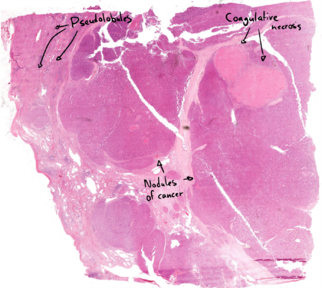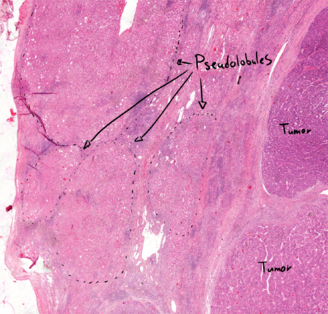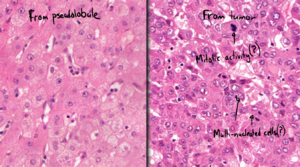9. Hepatocellular carcinoma in cirrhosis: Difference between revisions
(Created page with "'''Staining''': HE '''Organ''': Liver '''Description''': There is no healthy liver parenchyme visible. On the left part of the slides can we see some pseudolobules of varying size and without central veins. On the rest of the slide can we see large nodules with cells that show pleiomorphism, atypia and mitotic activity. Some of the tumor cells show intranuclear inclusion bodies. Coagulative necrosis is also visible in the in the upper right corner inside the right l...") |
No edit summary |
||
| Line 1: | Line 1: | ||
'''Staining''': HE | [[File:HCC - overview.png|thumb|Overview|322x322px]]'''Staining''': HE | ||
'''Organ''': Liver | '''Organ''': Liver | ||
| Line 11: | Line 11: | ||
On the rest of the slide can we see large nodules with cells that show pleiomorphism, atypia and mitotic activity. Some of the tumor cells show intranuclear inclusion bodies. Coagulative necrosis is also visible in the in the upper right corner inside the right large nodule. | On the rest of the slide can we see large nodules with cells that show pleiomorphism, atypia and mitotic activity. Some of the tumor cells show intranuclear inclusion bodies. Coagulative necrosis is also visible in the in the upper right corner inside the right large nodule. | ||
'''Diagnosis''': Hepatocellular carcinoma (<abbr>HCC</abbr>) | '''Diagnosis''': Hepatocellular carcinoma (<abbr>HCC</abbr>)[[File:HCC - pseudolobules.png|thumb|Recall that pseudolobules are lobules of varying size without central veins.|328x328px]]'''Causes''': | ||
'''Causes''': | |||
* Alcoholic/viral/metabolic hepatitis -> cirrhosis -> HCC | * Alcoholic/viral/metabolic hepatitis -> cirrhosis -> HCC | ||
| Line 22: | Line 20: | ||
Almost all cases of hepatocellular carcinoma develop in cirrhotic livers. The only exception is the ''fibrolamellar'' type of HCC. | Almost all cases of hepatocellular carcinoma develop in cirrhotic livers. The only exception is the ''fibrolamellar'' type of HCC. | ||
[[File:HCC - tumour.png|thumb|The tumour cells show sign of atypia/pleiomorphism and mitotic activity.|left]] | |||
[[File:HCC - tumour.png | |||
[[Category:Pathology 2 - Histopathology slides]] | [[Category:Pathology 2 - Histopathology slides]] | ||
Latest revision as of 13:28, 7 July 2024

Staining: HE
Organ: Liver
Description:
There is no healthy liver parenchyme visible.
On the left part of the slides can we see some pseudolobules of varying size and without central veins.
On the rest of the slide can we see large nodules with cells that show pleiomorphism, atypia and mitotic activity. Some of the tumor cells show intranuclear inclusion bodies. Coagulative necrosis is also visible in the in the upper right corner inside the right large nodule.
Diagnosis: Hepatocellular carcinoma (HCC)

Causes:
- Alcoholic/viral/metabolic hepatitis -> cirrhosis -> HCC
Theory:
The pseudolobules indicate that there is cirrhosis present. The larger nodules with atypia and necrosis are nodules of the hepatocellular carcinoma.
Almost all cases of hepatocellular carcinoma develop in cirrhotic livers. The only exception is the fibrolamellar type of HCC.

